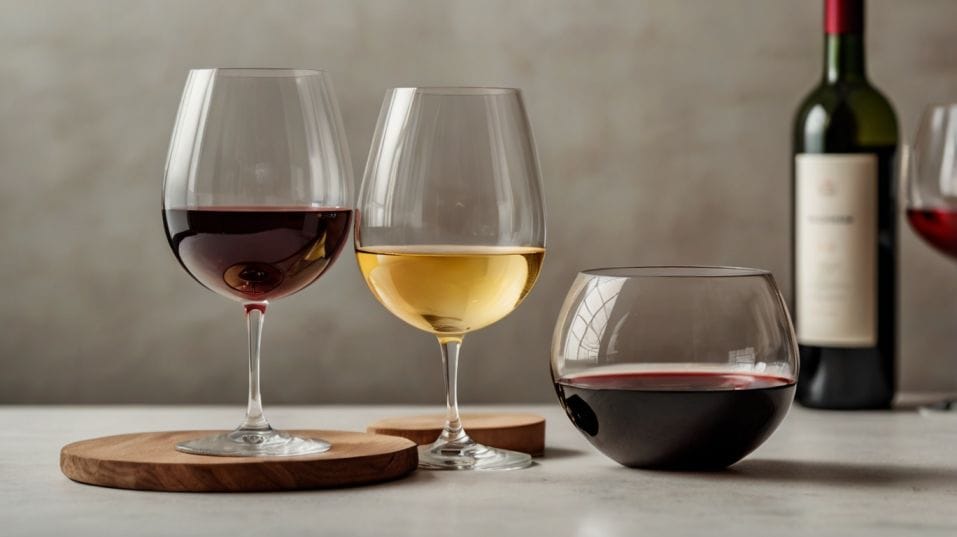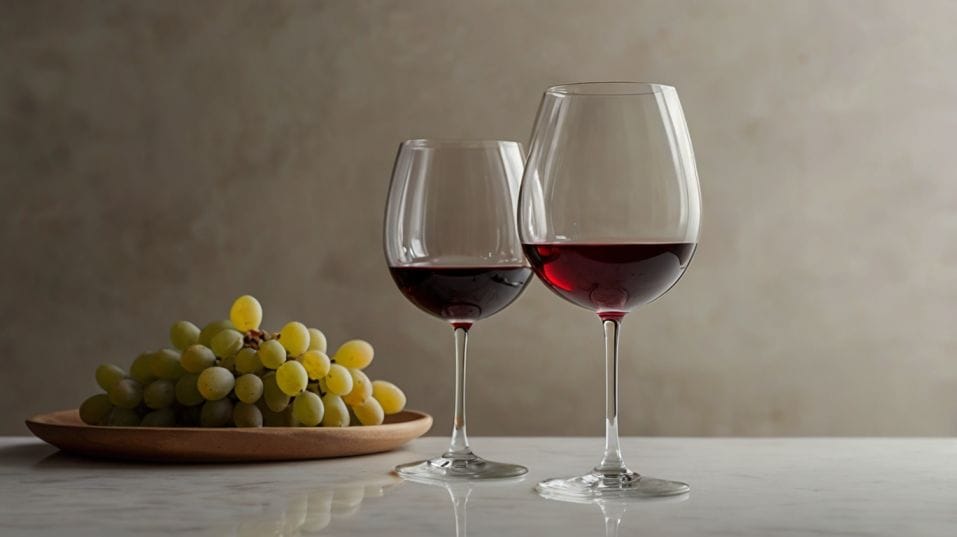Red vs White: What You’ll Actually Taste
Learn how red and white wines truly differ—in taste, texture, and feel—so you can choose, sip, and pair with confidence, even as a beginner.

What actually makes red and white wines feel so different in the glass? If you're just getting into wine, that’s the question to start with. It's not just about color—it's about texture, structure, and sensation.
This guide goes beyond surface-level advice to reveal what you're really tasting, and why it matters. No apps, no jargon—just a clearer, more confident way to explore the two most essential wine styles.
Beyond Color: What Makes Red and White Different
Color is the most obvious distinction—but it’s not where the real differences live. The most important shift between red and white wines comes down to how they’re made, and how that affects what you taste.
Red wines are fermented with their skins. That’s where tannins come from—compounds that add structure, bitterness, and that drying sensation you feel along your gums.
The skins also give color and contribute to mouthfeel. Reds are designed to be textured, layered, and slow to unfold.
White wines, on the other hand, are pressed off the skins right away. No tannin extraction. No color. What you’re left with is juice that’s typically crisper, lighter, and more driven by acidity than tannin.
That brightness makes white wines feel more immediate and refreshing, and it also highlights a very different set of flavors.
These differences aren’t just technical—they’re what shape the entire tasting experience. Structure is the scaffolding of flavor. Once you learn to feel it, you start to anticipate it.

Red Wine: Warmth, Grip, and Depth
Red wines are often described as bold or full-bodied. But what does that really mean? In practice, reds tend to feel heavier in the mouth. That weight comes from a mix of tannin, alcohol, and extract (concentration of flavor compounds).
When you sip a red, notice the sensation across your tongue: does it feel plush, dense, even chewy? That’s body. That’s tannin. That’s the skin contact at work.
Flavor-wise, reds lean toward darker fruit: blackberry, plum, black cherry. But they rarely stop at fruit.
The best reds carry earthiness—notes of forest floor, mushroom, leather, or dried herbs. You’ll often find spice tones too, from clove to pepper, depending on oak aging and varietal.
As reds age, the fruit softens and the savory elements rise. Young reds can taste bright and juicy; older reds become more mellow, often with a silkier mouthfeel.
A good red rewards patience—both in aging and in the glass. Don’t rush it. Let it open up, and you’ll taste more with every minute.
White Wine: Clarity, Energy, and Precision
White wines are built around acidity, not tannin. That acidity makes them feel fresh, electric, and often mouthwatering. Think of biting into a crisp apple or a just-ripe pear. That snap, that zing—that’s the backbone of most whites.
The fruit profile in whites usually leans lighter: green apple, lemon, peach, pear, melon. Some whites can be floral, like jasmine or honeysuckle.
Others show minerality—a stony or chalky edge that feels clean rather than fruity. In cooler climates, you’ll often get sharper citrus notes; in warmer climates, riper stone fruit or tropical hints.
But white wine doesn’t mean simple. Some of the most structured, age-worthy wines in the world are white—built not on weight, but on tension.
Wines like Chardonnay or Riesling can show creamy textures, flinty edges, or honeyed depth over time. With the right glass and temperature, a white wine can unfold just as slowly and elegantly as any red.
What You're Feeling Is Just As Important As What You're Tasting
Tasting is more than identifying fruit. It’s about noticing how the wine behaves on your palate. Red wines tend to linger, coating your mouth with tannin and warmth.
They sit low and wide on the tongue. White wines are sharper, brighter, more vertical. They move quickly and leave your mouth clean, sometimes even salivating.
These physical sensations matter. They shape not only your personal preferences but also how wine works with food.
Reds bring grip and gravity
They pair well with fatty cuts, roasted flavors, or richly seasoned dishes. The tannin binds with protein, softening the wine and refreshing your palate.
Whites bring lift and tension
They cut through richness, refresh salty bites, and amplify delicate ingredients like shellfish, herbs, or citrus-based sauces. The acid resets your mouth between bites.
When you understand how wine feels, you start to match it with meals more intuitively. No need to memorize pairings—you just learn to trust your senses.
How to Choose (and Taste) Smarter
Choosing between red and white doesn’t have to be complicated. Start by asking how you want the wine to make you feel.
Do you want something grounding, plush, and lingering? Go with red. Craving something clean, sharp, and vivid? Reach for white.
But go further than color. When you buy a bottle or sit down for a tasting, think about:
- Body: Does it feel light or heavy?
- Texture: Is it smooth, grippy, sharp, or creamy?
- Finish: Does the flavor fade fast, or does it linger?
You don’t need to use textbook terms. Just observe. The more you pay attention to these details, the more fluent you become.
And don’t overlook temperature. Serving matters. Most reds taste better just below room temperature—around 60–65°F. Too warm, and alcohol dominates.
Whites open up around 45–55°F. Too cold, and you lose nuance. Let the wine sit for a few minutes in the glass and taste it again. Small shifts make a big difference.
Final Thoughts
Understanding red vs. white isn’t about knowing everything. It’s about knowing enough to taste with intention. You’re not memorizing flavor wheels—you’re building a vocabulary of sensation.
Red wines offer grip, depth, and evolution in the glass. White wines deliver clarity, brightness, and tension. Both can be complex. Both can be elegant. And both reward attention far more than they require expertise.
So take the next step. Revisit a wine you think you “know.” Taste it slower. Feel its weight. Follow it through to the finish.
Or flip your routine—serve a white where you’d usually pour a red. Explore how it changes the meal, the moment, or your own preferences.
One small shift—one curious sip—is how real wine understanding starts. Try it today. Your palate is ready.




